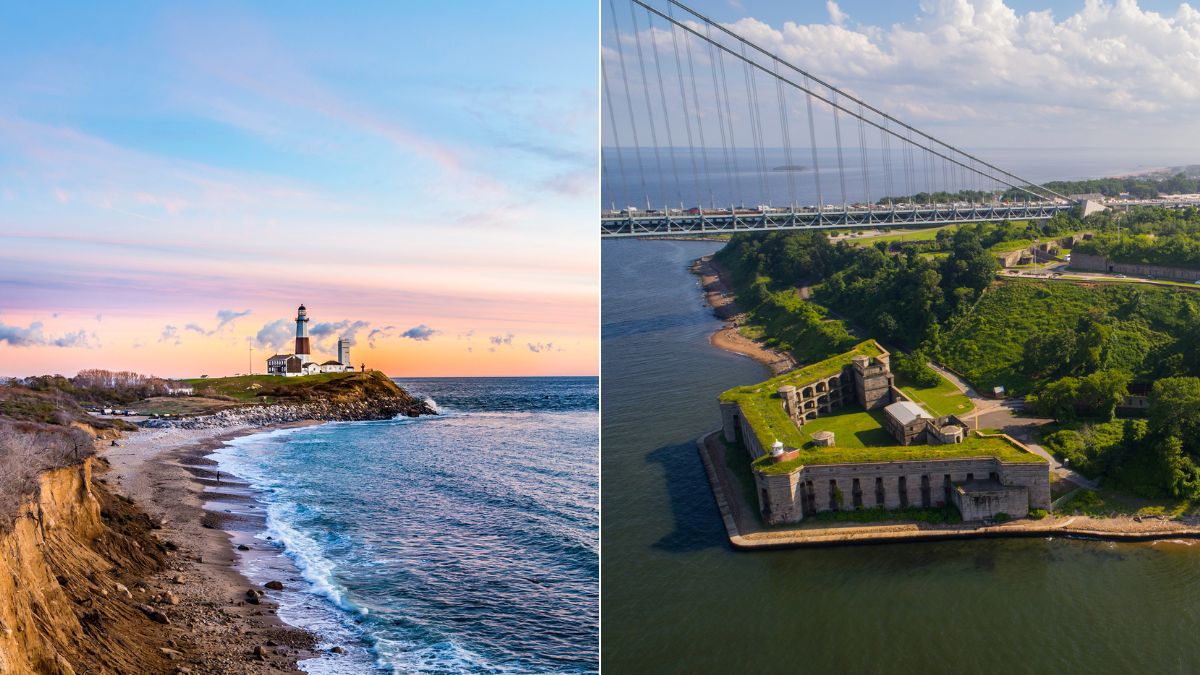Long Island Vs. Staten Island: Diverse Histories, Distinct Cultures

As participants in Amazon Associates and other programs, we earn from qualifying purchases. This comes at no additional cost to you. For more details, see our Affiliate Disclosure.
Nestled within the vast expanse of New York, both Long Island and Staten Island stand as distinct entities, each boasting a rich tapestry of history and a unique cultural milieu. While both islands are geographically close and share the New York moniker, they diverge in terms of historical events, influences, and the resultant cultural evolutions. This article delves into the captivating journey of Long Island and Staten Island, drawing contrasts and highlighting their individual charm.
HIGHLIGHTS
- Both Long Island and Staten Island possess rich histories and cultural tapestries, but Long Island’s extensive historical events and broader range of landmarks offer a slight edge.
- Staten Island maintains a distinct cultural identity amidst the vastness of NYC, particularly its unique multicultural charm.
- Long Island boasts a diversified economy spanning multiple sectors, contributing significantly to New York’s economic landscape.
- Both islands have showcased remarkable resilience in the face of challenges, adapting and evolving to meet the needs of their communities.
Geographical Overview: Two Islands, One State
New York State, famed for its bustling cityscapes and iconic landmarks, is also home to two noteworthy islands: Long Island and Staten Island.
Positioned to the east of Manhattan, Long Island stretches over 118 miles from New York Harbor to the Atlantic Ocean, encompassing four counties: Kings (Brooklyn), Queens, Nassau, and Suffolk. It is characterized by its suburban sprawls, sandy beaches, and the famed Hamptons on its eastern end.
Conversely, Staten Island, or Richmond County, is the southernmost part of both the city and state of New York. It lies in the New York Harbor, separated from New Jersey by the Arthur Kill and the Kill Van Kull, and from the rest of New York by the Narrows. Smaller than its eastern counterpart, Staten Island presents a unique blend of urban and suburban environments, with expansive parks and green areas amidst its neighborhoods.
Both islands, while part of the vast New York tapestry, offer distinct landscapes, atmospheres, and experiences. Their geographical proximity to Manhattan and each other belies the diversity and individuality each brings to the state’s dynamic tableau.
Historical Milestones: Roots and Evolution
Tracing the histories of Long Island and Staten Island unveils a rich tapestry of events, influences, and developments that have shaped their current identities.
Long Island
Initially inhabited by Native American tribes like the Lenape and Algonquin, Long Island became a point of interest for European explorers in the 16th century. The Dutch were the first to establish settlements here, but by the mid-17th century, the English had taken control.
The island played pivotal roles in the Revolutionary War, with the Battle of Long Island being one of the war’s earliest and largest skirmishes. The 20th century saw the island rapidly suburbanize, with the construction of the Long Island Rail Road and parkways promoting its growth and development.
Staten Island
Also originally home to the Lenape tribe, Staten Island saw its first European explorers in the early 16th century. The Dutch established a permanent settlement by 1661, naming it “Staaten Eylandt” in honor of the Dutch parliament. Like Long Island, Staten Island had its share of Revolutionary War activity, but it’s also renowned for the “Staten Island Peace Conference” of 1776, a failed diplomatic attempt to end the war.
The 19th century brought about significant changes with the opening of the Staten Island Ferry service. The 20th century saw the construction of the Verrazzano-Narrows Bridge, which further integrated the island into the broader fabric of New York City.
Both islands have rich histories intertwined with the story of New York, but Long Island, with its larger expanse, played host to a wider range of events, notably the significant Battle of Long Island in the Revolutionary War. While Staten Island’s historical milestones are critical, especially the Peace Conference, the breadth of Long Island’s historical events gives it a slight edge in this category.
Cultural Tapestry: People, Traditions, and Influences
The cultural landscapes of Long Island and Staten Island are as diverse and intricate as the historical events that have shaped them. As melting pots of tradition, ethnicity, and innovation, both islands have crafted identities distinct from each other, yet quintessentially New York.
Long Island
Long Island’s vast expanse has given rise to a cultural mosaic. From the urban vibes of Brooklyn and Queens to the serene suburbs of Nassau and Suffolk, the island is a blend of worlds. Historically, it was a haven for artists, writers, and musicians—the likes of Jackson Pollock, Walt Whitman, and Billy Joel all called it home.
It’s also a hub for various ethnic communities, with neighborhoods like Little India in Hicksville and burgeoning Latino communities in areas like Brentwood. Traditional events, from the Montauk’s Blessing of the Fleet to the Hamptons International Film Festival, showcase the island’s diverse cultural and artistic heritage.
Staten Island
Often referred to as the “forgotten borough” of New York City, Staten Island’s cultural fabric is anything but forgettable. With strong Italian, Irish, and recently growing Russian and Sri Lankan communities, the island pulsates with multicultural charm. Landmarks like the Snug Harbor Cultural Center and Botanical Garden host a plethora of events, art shows, and performances that highlight the borough’s rich artistic tradition.
The annual Staten Island St. Patrick’s Day Parade and the Diwali Festival of Lights celebrations are testament to the island’s embrace of both its historic and newly formed cultural ties.
Staten Island’s “forgotten borough” status ironically gives it an edge in terms of preserving its unique multicultural charm, with strong Italian, Irish, and burgeoning communities like the Russian and Sri Lankan. Long Island’s cultural tapestry, though diverse, is more influenced by the broader trends of New York. For maintaining a distinct cultural identity amidst the vastness of NYC, Staten Island has a slight advantage.
Economic Pulse: Growth and Significance
At the crossroads of history and modernity, both Long Island and Staten Island have cultivated economies that reflect their unique characteristics, geographical advantages, and the evolution of industry over time. The economic trajectories of these islands not only reveal their individual growth but also underscore their broader contributions to New York’s economic powerhouse status.
Long Island
Historically rooted in agriculture, fishing, and whaling, Long Island underwent significant economic transformation in the 20th century. With the rise of the aerospace and defense industries, companies like Grumman and Sperry Rand became major employers, pushing Long Island to the forefront of aviation advancements.
The construction of the Long Island Rail Road catalyzed suburbanization, leading to increased property development and the establishment of numerous businesses. Today, the island boasts a diversified economy, with significant contributions from healthcare, education, and the service sector. Additionally, tourism, especially in regions like the Hamptons, contributes significantly to its economic vitality.
Staten Island
While historically more agrarian and maritime-focused, Staten Island has seen its economic landscape shift and diversify over the decades. The establishment of the Fresh Kills Landfill, once the world’s largest, provided numerous jobs, while its closure and ongoing transformation into a park symbolize adaptive economic change.
The development of the Staten Island Mall, the island’s transportation hubs, and the burgeoning tech sector have also propelled economic growth. Moreover, the revitalization of the North Shore waterfront with projects like Empire Outlets has further elevated Staten Island’s economic stature in retail and tourism.
Long Island, with its vast area, plays host to a diversified economy, from aerospace and defense to tourism in regions like the Hamptons. Its contributions in various sectors give it a significant weight in New York’s economy. While Staten Island has shown commendable economic growth, especially with revitalization projects, Long Island’s multifaceted economic contributions make it the winner in this category.
Landmarks and Highlights: Icons of Identity
The landscapes of Long Island and Staten Island are punctuated by landmarks that stand as testimonies to their rich histories, cultural evolutions, and the pride of their communities. These icons, ranging from historical sites to modern marvels, serve as anchors of identity for residents and destinations of interest for visitors.
Long Island
- The Hamptons: Renowned for its upscale homes, beaches, and cultural scene, this area is both a playground for the elite and a nexus of artistic expression.
- Montauk Point Lighthouse: As New York’s oldest lighthouse and a symbol of Long Island’s maritime history, it offers breathtaking views of the Atlantic.
- Old Westbury Gardens: This historic Gold Coast mansion and garden encapsulates the grandeur of an era gone by.
- Jones Beach State Park: A popular destination for relaxation, concerts, and events, this beach captures the island’s coastal charm.
- Brooklyn Bridge: Connecting Brooklyn to Manhattan, this architectural marvel stands as a symbol of unity and innovation.
Staten Island
- Staten Island Ferry: Beyond its practical function of transportation, the ferry offers unparalleled views of the Statue of Liberty, Ellis Island, and the Manhattan skyline.
- Snug Harbor Cultural Center and Botanical Garden: A multifaceted cultural venue, it’s a hub for arts, education, and horticultural pursuits.
- Historic Richmond Town: This living history village offers insights into colonial life, showcasing the island’s deep-rooted past.
- Verrazzano-Narrows Bridge: An engineering feat, this bridge not only connects Staten Island to Brooklyn but stands as a symbol of connectivity and progress.
While both islands have their set of iconic landmarks, Long Island, given its larger size and varied regions from Brooklyn to the Hamptons, offers a broader range of destinations. From the historical Montauk Point Lighthouse to the bustling urbanity of the Brooklyn Bridge, its landmarks cover a wider spectrum. Thus, Long Island takes the lead in this category.
Modern-Day Dynamics: Lifestyles and Communities
As the pages of history turn and the future unfolds, Long Island and Staten Island are ever-evolving, reflecting the changing times while maintaining their unique identities. The rhythms of daily life, influenced by their histories, geographical settings, and economic developments, give birth to distinctive lifestyles and community bonds.
Long Island
- Suburban Meets Urban: With the bustling boroughs of Brooklyn and Queens on its western end, and the tranquil suburbs of Nassau and Suffolk to the east, Long Island offers a blend of urban excitement and suburban serenity.
- Educational and Research Hubs: Institutions like Stony Brook University and Cold Spring Harbor Laboratory are at the forefront of education and research, attracting global talent.
- Artistic Vibrancy: From North Fork wineries hosting jazz nights to Hamptons galleries showcasing contemporary art, there’s a rich tapestry of creative expression.
- Community Engagement: Farmer markets in Huntington, summer concerts in Jones Beach, and local festivals in villages underline the island’s strong sense of community.
Staten Island
- Green Borough: Despite its urban setting, Staten Island boasts vast green spaces like the Greenbelt, making it a haven for nature enthusiasts.
- Multicultural Mosaic: Its neighborhoods are home to a diverse range of communities, from longstanding Italian and Irish roots to newer Sri Lankan and Liberian populations.
- Civic Pride: Initiatives like the transformation of the Fresh Kills Landfill into a park symbolize the borough’s commitment to environmental and community betterment.
- A Mix of Old and New: From historic homes in St. George to the modern shopping experiences at Empire Outlets, Staten Island offers a juxtaposition of the traditional and the contemporary.
Long Island’s blend of urban and suburban offers varied lifestyles, while Staten Island’s mix of urban settings with vast green spaces provides a unique living experience. Both islands cater to different preferences. For those who prefer a harmonious blend of urban excitement and suburban calm, Long Island is the choice. For those drawn to urban living with an emphasis on nature and community closeness, Staten Island emerges as the preferred choice.
Challenges and Resilience: Past Struggles and Future Prospects
Every region, in its journey through time, encounters challenges that test the mettle of its communities. For Long Island and Staten Island, these challenges have not only been met with resilience but have often paved the way for innovation, growth, and unity.
Long Island
- Environmental Concerns: With its extensive coastline, Long Island faces the threats of erosion, rising sea levels, and pollution. The aftermath of events like Hurricane Sandy brought to the forefront the need for improved coastal defenses and sustainable practices.
- Economic Disparities: While areas like the Hamptons depict affluence, other regions grapple with economic challenges and disparities, necessitating targeted interventions and support.
- Infrastructure and Transportation: Ensuring seamless connectivity across such a vast area remains an ongoing challenge. Proposals for improved rail systems, road networks, and public transportation aim to address these needs.
- Future Readiness: As industries evolve, the island’s focus on technology, research, and sustainable practices seeks to position it for future economic and societal shifts.
Staten Island
- Urban Development vs. Conservation: Balancing the borough’s green spaces with the demands of urbanization requires careful planning and community involvement.
- Transportation Bottlenecks: With limited connection points to other boroughs, improving transportation efficiency remains a priority.
- Economic Diversification: While there has been significant growth, there’s a continuous push towards diversifying the economy and attracting varied industries to the island.
- Community Integration: As one of the most diverse boroughs, fostering unity, understanding, and collaboration among its various communities is both a challenge and an opportunity.
Both islands have shown commendable resilience in the face of challenges. While Long Island’s focus on technological and sustainable advancements positions it well for future challenges, Staten Island’s efforts in community integration and balancing urban development with conservation are noteworthy.






